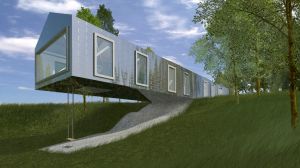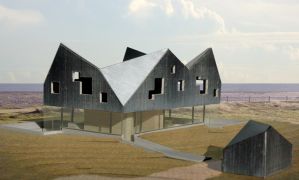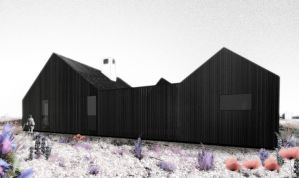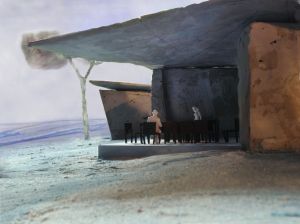Living Architecture | reviews, news & interviews
Living Architecture
Living Architecture
Alain de Botton writes of his plans to bring designer architecture to the people
Country hotels compete among themselves to tell us how ancient they are; holiday cottages vaunt that they were already in existence when Jane Austen was a girl. The draughty sash window shows no signs of retiring. Inheriting furniture and not bothering with plumbing continue to function as mysterious symbols of status.
 A few years ago, I wrote a book about architecture critical of our nostalgia and low expectations. It got a healthy amount of attention, on the back of which I was invited to a stream of conferences about the future of architecture. But one night, returning from one such conference in Bristol, I had a dark moment of the soul. I realised that however pleasing it is to write a book about an issue one feels passionately about, the truth is that - a few exceptions aside - books don't change anything. I realised that if I cared so much about architecture, writing was just a coward's way out; the real challenge was to build.
A few years ago, I wrote a book about architecture critical of our nostalgia and low expectations. It got a healthy amount of attention, on the back of which I was invited to a stream of conferences about the future of architecture. But one night, returning from one such conference in Bristol, I had a dark moment of the soul. I realised that however pleasing it is to write a book about an issue one feels passionately about, the truth is that - a few exceptions aside - books don't change anything. I realised that if I cared so much about architecture, writing was just a coward's way out; the real challenge was to build.
So on the back of a notepad was born a project which is now officially launched: Living Architecture is a not-for-profit organisation that puts up houses around the UK designed by some of the world's top architects and makes these available to the public to rent for holidays throughout the year. We describe it as a Landmark Trust for contemporary architecture.
 Our dream was to allow people to experience what it is like to live and sleep in a space designed by an outstanding architectural practice. While there are examples of great modern buildings in Britain, they tend to be in places that one passes through (airports, museums, offices), and the few modern houses that exist are almost all in private hands and cannot be visited. This seriously skews discussions of architecture. When people declare that they hate modern buildings they are on the whole speaking not from experience of homes, but from a distaste of post-war tower blocks or bland air-conditioned offices.
Our dream was to allow people to experience what it is like to live and sleep in a space designed by an outstanding architectural practice. While there are examples of great modern buildings in Britain, they tend to be in places that one passes through (airports, museums, offices), and the few modern houses that exist are almost all in private hands and cannot be visited. This seriously skews discussions of architecture. When people declare that they hate modern buildings they are on the whole speaking not from experience of homes, but from a distaste of post-war tower blocks or bland air-conditioned offices.
Living Architecture's houses are deliberately varied. One of them, by the Dutch firm MVRDV (model pictured above right), hangs precariously off the edge of a hill in Suffolk. Another in Thorpeness (model pictured above left), by the Norwegian architects JVA, has four steel roofs, each of which houses a bedroom and a bathroom. A third, by the young Scottish practice NORD (model pictured below right), is a stark black box in the shadow of Dungeness nuclear power station. A fourth, by the legendary Swiss architect Peter Zumthor (model pictured below left), is a secular mini-monastery which aims to bring an ecclesiastical calm and solemnity to the Devon countryside.
 The idea has been to avoid the obvious and to place houses in locations one hadn't necessarily ever thought of holidaying in and to design rooms different from those that people know from their own homes. We also want to keep things accessible. Prices start at £20 per person per night and the buildings themselves, while always comfortable, are far from grand (the build cost was scrupulously held down to £2,200 per square metre).
The idea has been to avoid the obvious and to place houses in locations one hadn't necessarily ever thought of holidaying in and to design rooms different from those that people know from their own homes. We also want to keep things accessible. Prices start at £20 per person per night and the buildings themselves, while always comfortable, are far from grand (the build cost was scrupulously held down to £2,200 per square metre).
The organisation has an educational mission at its core, a wish to teach as well as to soothe and relax; that there are REN toileteries in the bathrooms is just a way of sweetening the pill of learning. We have been criticised in some quarters for building holiday homes when there is an overall housing shortage, to which we'd simply answer that the organisation in fact hopes to lessen the demand for second homes which places such pressure on rural economies and the environment.
In the future, if we manage to get enough landowners and local authorities on board, we hope to be able to build one new house every year – and each time, to push the boundaries of architecture a little more. We want to build a tower on the Isle of Sheppey, a house for a modern hermit in the East Anglian fenlands, a low-cost eco house outside Aberdeen and a cojoined building for a divorced family in the Yorkshire moors.
For a writer, it was undeniably something of a challenge to have to become a practical sort of person. Behind every house lies a seemingly endless procession of meetings with donors, local authorities, architects, waste disposal experts and cutlery manufacturers.The house rental business demands a keen attention to detail: you won't get far without an in-depth knowledge of mattress protectors and the best dog policy (yes, but not in the bedrooms). Yet there's fun in the minutiae. Whatever the pleasures of designing your own home, it's perhaps even more satisfying imagining someone else's holiday needs, to design their bedside library, welcome basket and closet.
 I wouldn't have driven this project forward if I didn't believe that architecture changes our characters. We are simply not the same people in whatever room we are in. For too long in Britain, our buildings have suggested that the past is the only worthy realm, that we have to dress in the clothes of yesteryear and that technology is bad and the future terrifying. Living Architecture's houses propose a new vision of the United Kingdom as a country that is reconciled to technology, that is no longer painfully in thrall to the past, that is democratic, tolerant, playful and optimistic.
I wouldn't have driven this project forward if I didn't believe that architecture changes our characters. We are simply not the same people in whatever room we are in. For too long in Britain, our buildings have suggested that the past is the only worthy realm, that we have to dress in the clothes of yesteryear and that technology is bad and the future terrifying. Living Architecture's houses propose a new vision of the United Kingdom as a country that is reconciled to technology, that is no longer painfully in thrall to the past, that is democratic, tolerant, playful and optimistic.
The salvation of British housing lies in raising standards of taste. If one considers how rapidly and overwhelmingly this has been achieved in cooking, there is much to be optimistic about. Consumers have learnt to ask probing questions about salt or fat levels which wouldn’t have occurred to a previous generation. With the right guidance, a similar sensitivity could rapidly be fashioned to the worst features of domestic buildings. My hope is that a holiday in a Living Architecture house will, in a modest but determined way, help to change the debate about what sort of houses we want to live in.
- Visit the Living Architecture website
- Alain de Botton discusses Living Architecture at the Victoria & Albert Museum on 17 September
- Buy The Architecture of Happiness by Alain de Botton on Amazon
more Visual arts
 Fantastic Machine review - photography's story from one camera to 45 billion
Love it or hate it, the photographic image has ensnared us all
Fantastic Machine review - photography's story from one camera to 45 billion
Love it or hate it, the photographic image has ensnared us all
 Yinka Shonibare: Suspended States, Serpentine Gallery review - pure delight
Weighty subject matter treated with the lightest of touch
Yinka Shonibare: Suspended States, Serpentine Gallery review - pure delight
Weighty subject matter treated with the lightest of touch
 Jane Harris: Ellipse, Frac Nouvelle-Aquitaine MÉCA, Bordeaux review - ovals to the fore
Persistence and conviction in the works of the late English painter
Jane Harris: Ellipse, Frac Nouvelle-Aquitaine MÉCA, Bordeaux review - ovals to the fore
Persistence and conviction in the works of the late English painter
 Sargent and Fashion, Tate Britain review - portraiture as a performance
London’s elite posing dressed up to the nines
Sargent and Fashion, Tate Britain review - portraiture as a performance
London’s elite posing dressed up to the nines
 Zineb Sedira: Dreams Have No Titles, Whitechapel Gallery review - a disorientating mix of fact and fiction
An exhibition that begs the question 'What and where is home?'
Zineb Sedira: Dreams Have No Titles, Whitechapel Gallery review - a disorientating mix of fact and fiction
An exhibition that begs the question 'What and where is home?'
 Yoko Ono: Music of the Mind, Tate Modern review - a fitting celebration of the early years
Acknowledgement as a major avant garde artist comes at 90
Yoko Ono: Music of the Mind, Tate Modern review - a fitting celebration of the early years
Acknowledgement as a major avant garde artist comes at 90
 Unravel: The Power and Politics of Textiles in Art, Barbican review - the fabric of dissent
An ambitious exploration of a neglected medium
Unravel: The Power and Politics of Textiles in Art, Barbican review - the fabric of dissent
An ambitious exploration of a neglected medium
 When Forms Come Alive, Hayward Gallery review - how to reduce good art to family fun
Seriously good sculptures presented as little more than playthings or jokes
When Forms Come Alive, Hayward Gallery review - how to reduce good art to family fun
Seriously good sculptures presented as little more than playthings or jokes
 Entangled Pasts 1768-now, Royal Academy review - an institution exploring its racist past
After a long, slow journey from invisibility to agency, black people finally get a look in
Entangled Pasts 1768-now, Royal Academy review - an institution exploring its racist past
After a long, slow journey from invisibility to agency, black people finally get a look in
 Barbara Kruger, Serpentine Gallery review - clever, funny and chilling installations
Exploring the lies, deceptions and hyperbole used to cajole, bully and manipulate us
Barbara Kruger, Serpentine Gallery review - clever, funny and chilling installations
Exploring the lies, deceptions and hyperbole used to cajole, bully and manipulate us
 Richard Dorment: Warhol After Warhol review - beyond criticism
A venerable art critic reflects on the darkest hearts of our aesthetic market
Richard Dorment: Warhol After Warhol review - beyond criticism
A venerable art critic reflects on the darkest hearts of our aesthetic market
 Dineo Seshee Raisibe Bopape: (ka) pheko ye / the dream to come, Kiasma, Helsinki review - psychic archaeology
The South African artist evokes the Finnish landscape in a multisensory installation
Dineo Seshee Raisibe Bopape: (ka) pheko ye / the dream to come, Kiasma, Helsinki review - psychic archaeology
The South African artist evokes the Finnish landscape in a multisensory installation

Add comment